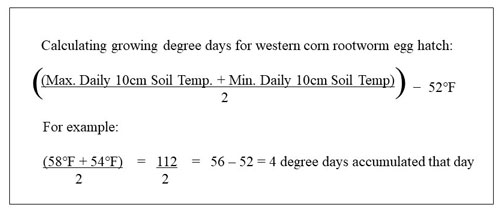To date, corn rootworm degree day accumulation for the northern half of Kansas is similar to the same time last year and egg hatching should begin in one to two weeks in most locations. In the southern portion of the state, egg hatching is well underway, and scouting for root damage should begin in south central Kansas in the coming week as degree day accumulation indicates peak egg hatch is approaching (Table 1).
Table 1. 2023 corn rootworm degree day accumulation compared to 2022 during the same time period. Calculated using 10 cm max/min ground temperatures provided by KSU Mesonet.
|
CRW Degree Day Accumulation as of May 23 |
|||
|
Location |
2022 |
2023 |
Difference |
|
Colby |
244 |
228 |
-16 |
|
Hays |
323 |
337 |
+14 |
|
Manhattan |
333 |
345 |
+12 |
|
Garden City |
529 |
495 |
-34 |
|
Meade |
517 |
619 |
+102 |
|
Parsons |
458 |
482 |
+24 |
Calculating Corn Rootworm Degree Days
As with all degree-day models, the base temperature, or developmental threshold, will be important for predicting rootworm hatch and emergence. Western corn rootworm eggs are laid in summer and overwinter in the soil. The following spring, a threshold soil temperature of 52°F or higher will trigger eggs to begin developing. This base temperature along with daily 10cm high and low soil temperatures are used to monitor egg hatch using the formula below. It is important to note that degree day calculations for egg hatch should begin starting January 1 of the current year.

Eggs should begin hatching after approximately 380-degree days have accumulated. Peak egg hatch occurs between 684-767 accumulated degree days. Examining corn roots for damage 10 to 14 days following peak hatch is recommended since feeding damage will be fresh and easier to detect.
Why it is important to scout for root damage
Western corn rootworm resistance to Bt corn continues to be an issue in continuous corn in the United States. Field evolved resistance was first detected in 2009 and, to date, resistance to every commercially available Bt trait package has been detected in corn-producing areas of the country. However, resistance is not uniform across all corn-growing regions, so check local conditions when making planting decisions. Given this, evaluating corn roots for rootworm damage during the growing season is highly recommended. Doing so allows you to get an idea of how well your rootworm management practices are working and provides a way to detect rootworm problems in first-year corn as well as the potential development of resistance to the Bt hybrid planted.
Details for the process of evaluating corn root damage can be found in the KSRE publication MF 845 Corn Rootworm Management in Kansas Field Corn. In short, several plants should be dug up throughout the field and their roots washed well for subsequent evaluation using the Iowa State University 1-3 Node Injury Scale. Digging roots will need to be timed after peak damage from rootworm larvae occurs but before roots begin to regrow, typically late June to early July. Corn rootworm resistance to a Bt protein should be considered if the node injury rating is 1.0 in a field with at least 2 consecutive years of use of the same single corn rootworm Bt toxin or if the node injury rating is greater than .5 in a field with at least 2 consecutive years use of the same pyramided corn rootworm Bt toxins.
It is important to remember that the best management tool for western corn rootworm is rotation. In continuous corn production, this includes rotating Bt traits annually to help slow the evolution of resistance. Rotation to a non-Bt hybrid combined with soil-applied insecticides would be another option for continuous corn. Both of these practices will be useful for prolonging the efficacy of currently available Bt traits.
Anthony Zukoff, Extension Entomology Associate – Garden City
azukoff@ksu.edu
Tags: insects corn corn rootworm degree days